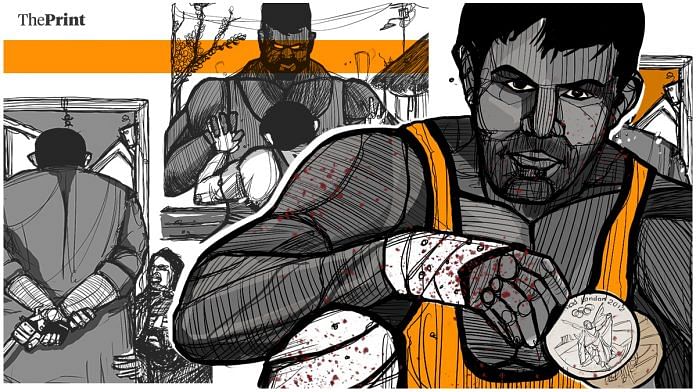Rohtak/Sonipat/New Delhi: The pot-bellied farmer with nothing more than a tuft on his head digs through his bottle gourd field, frequently squinting at the blazing sun. His demeanour shows no hint of what his past life was like – a former national-level wrestler who killed, kidnapped, and ran a mafia for a living. He was, and is, a dangerous man.
Murky world of mud and murder
Poverty and the desire for a government job pushed him into the murky world of Haryana’s wrestling. “But even after winning national championships, I was looked over,” he says wearily. By 28, this pehelwan’s career was in its twilight and there was no job in sight. “My uncle fell ill, and I quickly needed money for his treatment. An acquaintance offered me a cut for helping them recover a loan that they had extended. I reluctantly accepted. It was easy money. But things didn’t go as planned and I ended up killing one person,” he says, slurping from a glass of cold Coca-Cola. “From then it never stopped. Extortion, kidnapping, criminal intimidation, I did it all and earned good money.”
This pehelwan’s story is a typical example of why wrestlers turn criminals so often, a problem the world turned its attention to only after India’s most celebrated wrestler and two-time Olympic champion Sushil Kumar became a prime accused in the murder of his student Sagar Dhankad, who was allegedly beaten to death in the parking lot of Delhi’s Chhatrasal Stadium. How a man who revolutionised wrestling got inextricably entangled in crime is also the story of Haryana wrestling’s dizzying heights in which blood, money and mud are, at times, part of a criminal cauldron.
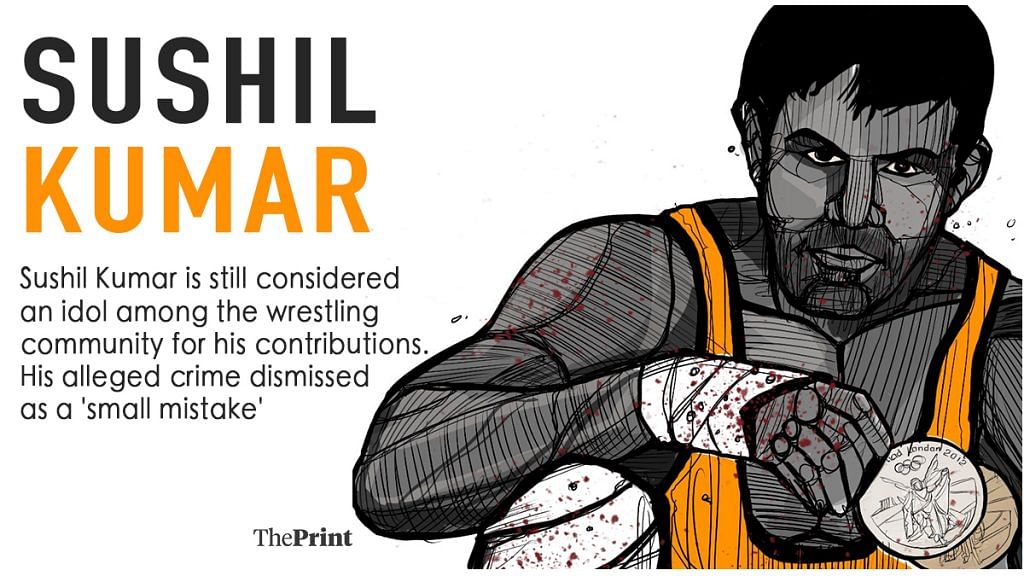
These two extremes of Indian wrestling are best exemplified in the stories of Olympic champion Ravi Kumar Dahiya, 23, and Anirudh Dahiya, 22, from Nahri village in Haryana’s Sonipat.
Both of them started on the same journey, from the same place, trained at the same akhada under the same coaches; but ended up with completely different fates. One, on the Olympic podium with the Indian flag on his shoulders and a silver medal around his neck. The other in Tihar jail, one among 13 accused of Sagar Dhankhar’s murder.
How did it happen? How could two young men, in similar circumstances, given equal opportunities, take such divergent paths? Ravi had been training at Chhatrasal Stadium since he was 11, while Anirudh was there since the age of 16. Both were hoping to measure up to their legacy. A village of 10,000, Nahri has produced legendary wrestlers and Arjuna Award winners Satveer Singh and Mahavir Singh, and more recently, two Olympians, Mahavir Singh (Moscow, 1980) and Amit Kumar Dahiya (London, 2012).
Yes, there have been other famous partnerships that have run aground, with one outstripping the other by leaps and bounds. In cricket, Sachin Tendulkar and Vinod Kambli are the examples cited most often, in ice-skating, Tonya Harding and Nancy Kerrigan have had the ugliest fallout, but none has been as dramatic as the triumph and tragedy of Nahri’s Dahiya boys.
Ravi had been winning international level championships since he was 17, from silvers at the Junior World Championships (2015) and World Under-23 Championships (2018), as well as gold medals at the Asian Championships in 2020 and 2021 in the 57 kg weight category. Described as a hardworking student by his coaches, he tuned out everything other than wrestling at Chhatrasal and simply focused on his game. “Ravi didn’t go out of his way to please Sushil. He kept to himself and didn’t talk much. He performed consistently at international competitions but there wasn’t an iota of arrogance in him,” says a staff member at the Chhatrasal Stadium.
Not to say Anirudh wasn’t a hard-working, dedicated wrestler. He was even-tempered, and not known to throw tantrums. Most describe his alleged involvement in the murder of Sagar Dhankhar as an ‘unfortunate accident’. His father, Bijender Singh aka Nandu Pehelwan, a former wrestler, would make daily trips from Nahri to Chhatrasal with milk, ghee and almonds for his boy every day. But Anirudh’s physique made him the perfect target for Sushil, who liked to travel with a posse of big boys. “Whenever Sushil wanted to go out to a function, wedding or felicitation, he liked to be escorted by some of the well-built students here. Almost six feet tall and 97 kg, Anirudh was among them. He just wanted to be in the good books of Sushil Pehelwan, and while hanging out with him he befriended some notorious people belonging to the gangs here. And look where that has landed him,” a wrestler at Chhatrasal told ThePrint on the condition of anonymity.
Ravi, sources in Chhatrasal said, was left alone because he was a medal hope. “If we were only indulging in crime here, would you have so many Olympic champions? Whatever Sushil was doing was his business. He didn’t disturb ‘serious’ students ever and let them train in peace,” the source said. There’s a reason why three out of the country four men’s Olympic champions are from Chhatrasal—Sushil Kumar, Yogeshwar Dutt, Ravi Kumar Dahiya are Chhatrasal products. Bajrang Punia also trained here till 2019.
There is something special about Chhatrasal. Its facilities outshine any other private akhada in the country. Virender Kumar, former coach at the stadium, says over the years senior wrestlers here have ensured that pehelwans here get the best facilities. “At Chhatrasal, the accommodation is good, some rooms even have air conditioners and are quite spacious. They have access to international coaches and dieticians, and even good physiotherapists who prescribe what to eat and when to eat. Other akhadas can neither afford so many facilities for training there nor do they have access to the latest information or scientific methods,” he said, “I want to take my boys from the Narela Akhada for swimming practice but I can’t. There’s no pool nearby. There are no such problems at Chhatrasal.”
But even so many facilities can’t ensure that every wrestler who walks through the gates of the stadium will turn out to be a star. It’s a familiar story. Only the cream gets the cream. Anirudh wasn’t in the top layer, as international medals eluded him. Yet he was eager to learn, and eager to please Sushil. “Sushil is considered the best in the game, like the Sachin Tendulkar of wrestling. Now if you see Sachin hanging out around you every day, wouldn’t you want to impress him?” says a source at Chhatrasal.
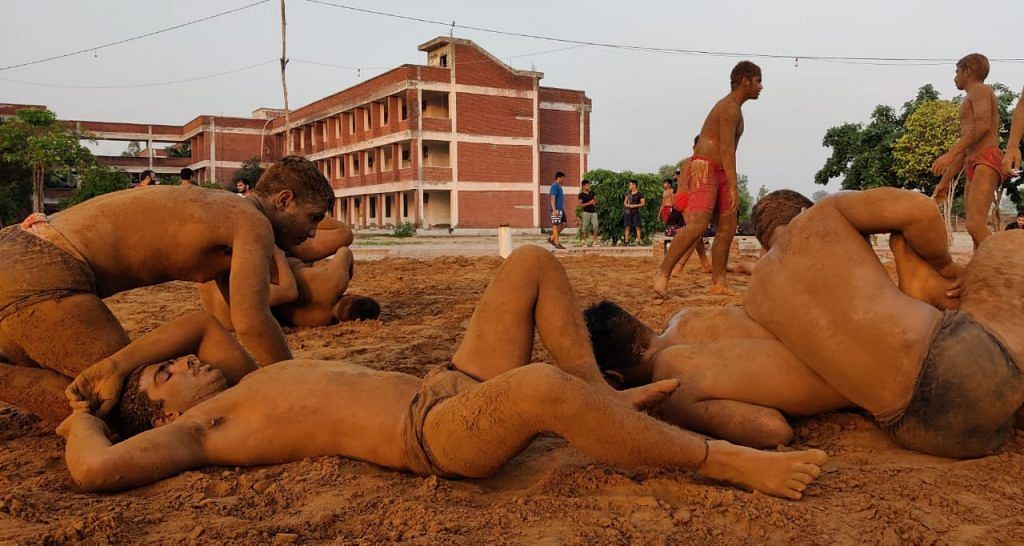
Also read: Sushil Kumar sought to re-establish supremacy among young wrestlers — Delhi Police charge sheet
Wrestling with crime
How was crime breeding at the most popular akhada in the country? And how did such tantalising stories revolving around a star like Sushil Kumar escape all of us? Lack of regulation of akhadas could be the answer. Traditionally, akhadas have been kept secluded from the outside world, with wrestlers expected to live disciplined lives, inspired by Lord Hanuman. Though things are changing, pehelwans are expected to practise celibacy and renounce the world.
The aggressive workout routine doesn’t leave space for engagement with the world outside. Spending even a minute at an akhada is enough to give anyone a complex about their body and fitness levels. Shirtless men can be seen doing up to 1,000 dands (burpees) for an hour straight, climb ropes with greater ease than most people ascend stairs and practise their technique in mud pits and on Olympic mats. Students are discouraged from using phones, watching TV or venturing out of the akhadas too frequently.
Just as the akhada stands secluded from the world outside, the outside world knows little of what goes on inside these academies, and that poses a serious problem. Nobody seemed to have any idea what was going on inside Chhatrasal Stadium in Delhi, whose supervisor’s actions were completely unhinged if stories about the atmosphere there are to be believed. That Sushil Kumar was entertaining and housing anti-social criminals elements at Chhatrasal seemed to be an open secret that everyone in wrestling knew about.
This is how his students like Anirudh, Surjeet and Rohit got embroiled in crime — they hung out with some of Sushil’s gangster friends only too frequently and ended up as alleged accomplices to a grave crime.
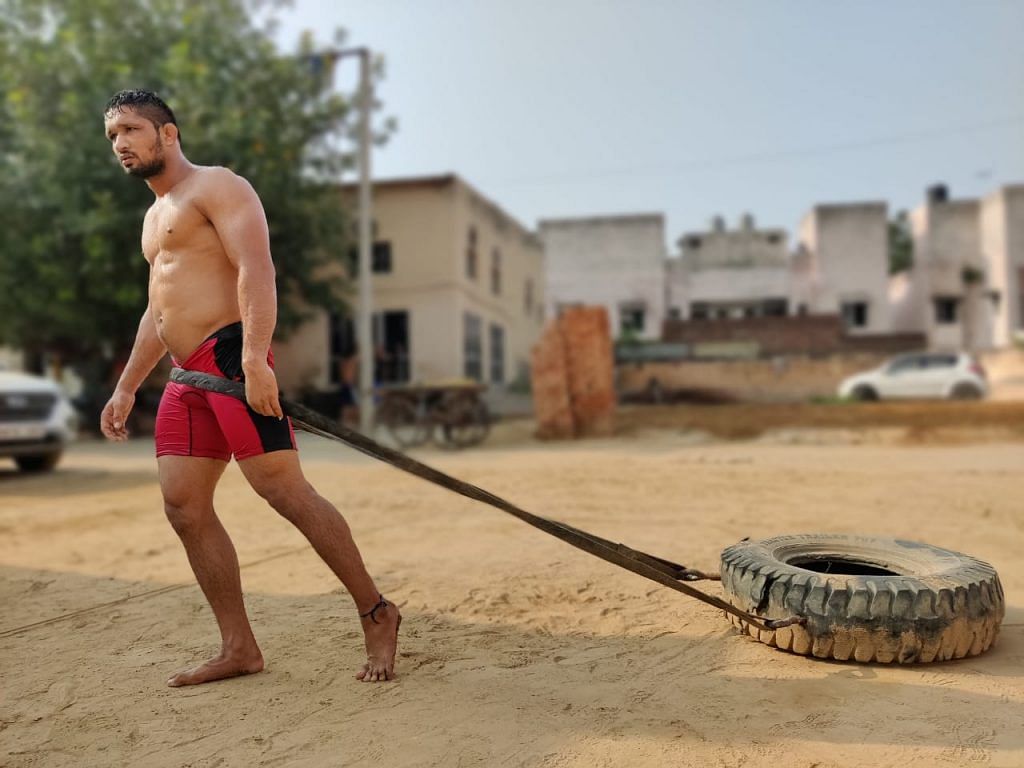
“Sushil didn’t keep good company, you know, constantly held meetings with well-known gangsters over here. He gave residence to a bunch of badmash men who weren’t even training as students. It was difficult to step out of the house after 6 p.m.,” a wrestler at Chhatrasal who didn’t wish to be named told ThePrint. Wrestler Praveen Rana who trained at the stadium till 2014 says, “Sushil would often come to the stadium drunk at night. He would then summon wrestlers by firing gun shots in the air, and then force them to do dands, play kabaddi or wrestle or dance for his entertainment. But this is 2014, I don’t know what happened after that”.
Rana’s story is corroborated by many wrestlers, some of whom left Chhatrasal in 2020 or still coach or train there. Sushil Kumar is still celebrated as the man who revolutionised wrestling and restored the glory of the sport. His fans still consider the alleged murder of Dhankhar to be nothing more than a pardonable ‘mistake’.
An IPS officer, on condition of anonymity, underlines his disgruntlement with the sports departments and the inadequate monitoring of akhadas. “Hundreds of boys live in these akhadas which are mostly unregulated. We don’t know what goes on here. There are no set systems of redressal, there’s no way to complain of harassment, simply no way for us to know how coaches are treating the kids here, how they live and who they talk to,” he says.
Abuse of students is widespread and is usually ascribed to the guru-chela tradition. It can take the form of beatings as well as abusive language. One coach slapped a boy twice his size in front of all other wrestlers at an akhada because he didn’t like the way the boy wished him good morning. This is often done to channelise aggression in the boys, says a coach: “You won’t want to fight with someone unless you feel angry, it’s an emotion integral to our sport.”

But how much regulation can such entities be subjected to? Director, sports and youth affairs, Haryana, Pankaj Nain says there’s only so much the government can do about private akhadas. “We encourage such private enterprises but we stay out of their business. Why should the government monitor them? In the spirit of uplifting the sport though we help them with certain equipment and depute National Institute of Sports-trained coaches at akhadas,” Nain told ThePrint over the phone.
But not everyone makes it big. Those who don’t make it to the international level or land a government job often end up as bouncers in NCR pubs and nightclubs, work with event management companies or as private bodyguards. Sometimes, local goons befriend pehelwans, and slowly induct them into their gangs, prodding them to do questionable things in the name of brotherhood. Contemporary India has many uses for Haryana’s brawn power.
The guru-chela power dynamic also gives disproportionate power to coaches and trainers to force young pehelwans to do their bidding. “These coaches often harass students to carry out shady jobs for them, or threaten to destroy their career by not sending them to competitions,” says a police officer.
Wrestlers insist akhadas are ‘pavitra’ and that coaches don’t force them into crime, but the Sushil Kumar case tells a different story, where three (Anirudh Dahiya, Surjeet Grewal, Rohit Malik) of the 13 accused are students who trained at Chhatrasal. Fifty-year-old Bijender ‘Binder’ Singh is also a professional wrestler as is another accused, 22-year-old Gaurav Laura.
Ranbir Dhaka, former coach at Mehar Singh Akhada, Rohtak, blames unemployment, poverty and lack of education as the main reasons why wrestlers’ involvement in crime. “I can show you 25 players within this akhada who have won medals at the national level, but haven’t found jobs anywhere. Some of them are approaching their 30s and very soon they’ll have nothing to do, they have no other skill set,” he told ThePrint. “In my experience, only 30 per cent of those training in this akhada will get jobs, and this is one of the premier akhadas in the country,” he said.
Also read: After high protein diet demand, Sushil Kumar now seeks TV for wrestling updates
Climbing out of poverty
Yet many families enroll their kids in akhadas in the hope that the sport will serve as a way out of poverty. But after a point of time, even their diets become impossible for these families to maintain. “About a kilogram of almonds and 3-4 kg milk, protein powder, juice and fruits. That is typically what these boys are expected to eat. The diet alone sets you back by Rs 25,000-30,000 a month,” says Dhaka. According to various wrestling coaches, successful pehelwans can take home anywhere between Rs 10 lakh to 35 lakh just by participating in dangals (wrestling bouts). Dhaka believes that the suspension of dangals due to the pandemic drove many pehelwans into crime. “Dangals are the main source of income for many pehelwans, without them what will they do? They have no other way of earning money. I worry what kind of effect this suspension has had and will continue to have on the pehelwans,” he said.
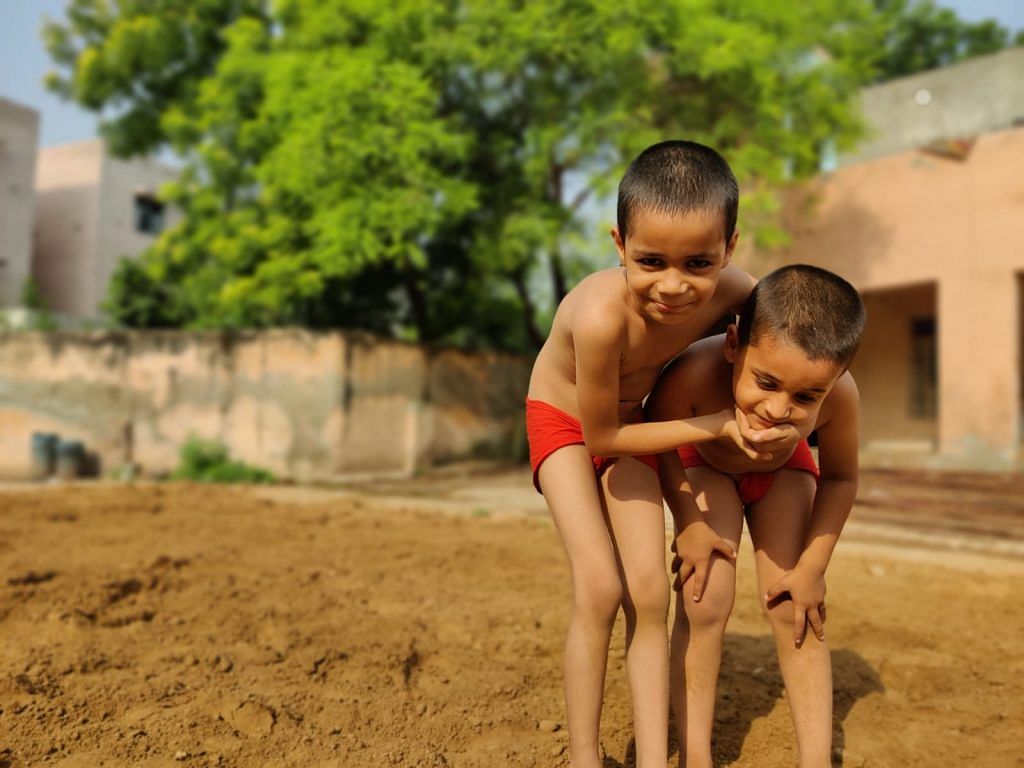
Nain contests this claim. “If you represent Haryana in the national games and win medals a job is guaranteed. But let’s not conflate all ‘national level tournaments’ with national games. Some of these wrestlers win random, privately organised national level tournaments and declare themselves national champions,” he says, adding the state government has increased sports quota jobs for class A, B and C services from 3 per cent to 10 per cent. They’ve also discontinued written examinations.
In India, wrestling schools are usually residential, and pehelwans-in-making don’t go to school. They train for about 8 hours a day, play sports like basketball, football and volleyball for entertainment. Their day starts at 4 in the morning and ends at 10. Their life, in a nutshell, is: Train, eat, sleep and repeat. The lack of formal education leaves them with limited career prospects. “Unlike other sports, say boxing or badminton, wrestlers typically go to stay in wrestling schools or akhadas when they’re very young. Lack of infrastructure for wrestling at private schools and colleges across the country limits places they can coach at too,” says Manali-based wrestling coach Ajit Singh. “At a good hotel in Delhi, bouncers or security staff can earn up to Rs 25,000-30,000. Many unsuccessful wrestlers are ok with making that kind of money, because frankly, they don’t have a lot to choose from.”
In some cases then, crime becomes the only option. The crimes you’d typically find a wrestler involved in are illegal claiming of land or plot, intimidation, loan recovery, kidnapping and extortion. What starts with ‘harmless’ intimidation by just flexing your muscles threateningly can slowly snowball into wrestlers committing grave crimes like murder. “Jahan vasooli hai, wahan pehelwan hai,” explains Ajit Singh, “pehelwans get involved in resolving property disputes most commonly. Earlier a lot of wrestlers were called to ‘steal’ tenders from contractors,” he says. Singh also runs a video series on YouTube called ‘Dadda ki khari khari’, immensely popular within the wrestling community, and among those interested in the game, where he talks about how crime and wrestling are intertwined.
“There’s also something to be said about the nature of the sport we’ve to teach them how to be angry, if they don’t feel aggression, how will they compete in a pit? Wrestlers are generally fearless, mindless and angry young men, what better formula does one need in making a criminal?” a coach, wishing to stay anonymous, said.
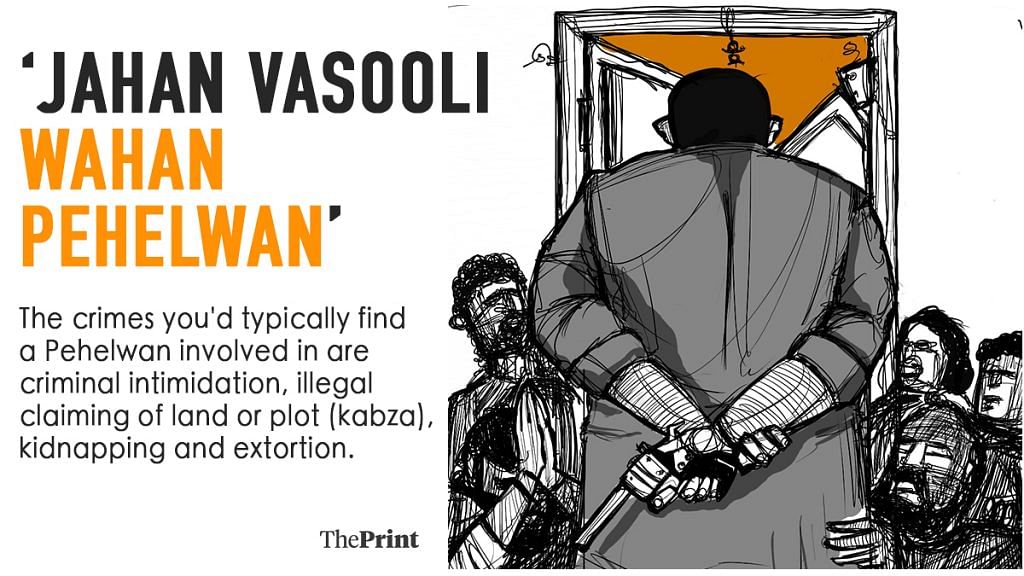
Local gang members also scour social media to know which wrestler is training where, and who has a feud with whom online, a police officer said on the condition of anonymity.
Former Haryana Pradesh Congress Committee president Ashok Tanwar says politicians also employ wrestlers to do their dirty jobs, and that akhadas are the easiest places for politicians to find muscle power. Tanwar says he realised this in 2016, when he was allegedly attacked by lathi-wielding goons near Bhairo Mandir New Delhi. “I cannot forget that day in October 2016… I was surrounded by these well-built men with swollen ears, the classic way to identify a pehelwan. That’s when I realised exactly where local goons are hired from. They hit me on the back of my head, and with so much power that five years after the incident here I am still taking medicines for it.” Tanwar adds that “even the proxies the government places in between protesters to park violence are hired from these akhadas.”
When asked how he could confidently say the goons were wrestlers, Tanwar said, “ Will you go to a gym and get tens of well-built powerful men eager to get into a fight? No, akhadas are the best place to find muscle power.”
The connection between crime and wrestling, say veteran wrestlers, can be traced back to late ’80s Delhi, when pehelwans reigned supreme, and pehelwan hooliganism was rampant. After the anti-Sikh riots of 1984, many Sikh properties including shops, bungalows and stores had been illegally occupied. Relatives of deceased Sikhs who had survived the riots took help of wrestlers in order to reclaim their lost property. “We would charge as much as Rs 1 lakh or even do it for free for Sikhs who wanted help reclaim their property back then. It led to the formation of gangs and there was a lot of infighting. If anyone started gangs in Delhi, it was the pehelwans,” says a former wrestler who trained at the Captain Chand Roop Akhada and now runs an akhada of his own in Haryana.
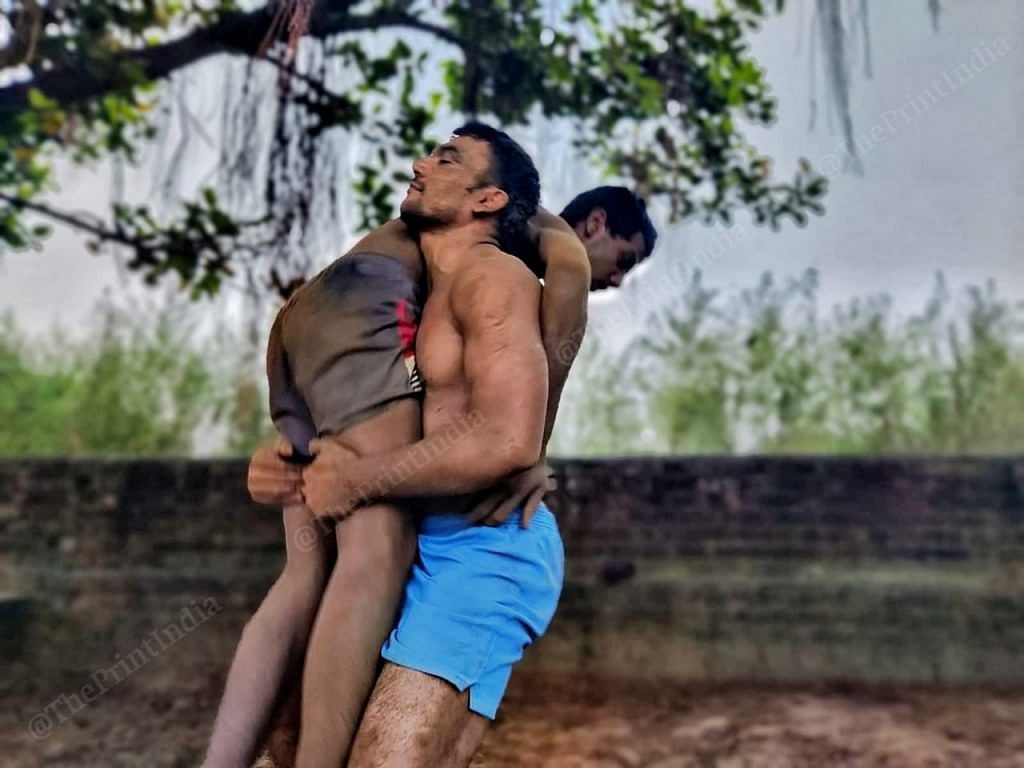
Also read: For India’s revolutionaries in freedom struggle, gyms & akharas were a cover for politics
Property as profitable
Former Director General of Police, Delhi, LN Rao agrees, saying wrestlers realised settling property disputes was a profitable business. From here on there was no stopping them. Slowly criminals in Delhi secured weapons and started indulging in criminal intimidation. “The wrestlers-turned-criminals used to make a list of businessmen involved in criminal activities in Delhi, then they used to target them and extort money,” says Rao. The DGP adds that these wrestlers were considered so powerful that nobody would dare say a word against them. So in 2001, the Delhi Police implemented the stringent Maharashtra Control of Organised Act (1999), just to put an end to gang wars started by the wrestlers. If booked under the act, the accused cannot secure bail. “We started cracking down on the akhadas with the help of MCOA, after which we got some control of the situation, which remained particularly bad till 2010, but is still going on,” he says.
Yet wrestlers believe that their reputation has been tarnished unnecessarily. Even Ajit Singh, who is vocal about the problem of crime plaguing the wrestling community says “only those who fail as wrestlers get involved in such crimes, it’s not like akhadas are the den of criminals, they’re pure places where parents send their kids with big hopes of achieving something in life”. Olympic champion Yogeshwar Dutt who won a bronze medal in the 60 kg category in the 2012 London Olympics says the criminal-wrestler nexus is exaggerated and that pehelwan is often used as an adjective, which doesn’t happen with other sports. Do you ever say ‘he’s an amazing badminton or she’s an amazing kabaddi?’ That dubious honour is reserved for the pehelwans of the world, and a couple of bad elements are out there ruining the name of the sport,” says Dutt.
Wrestling fans continue to admire Sushil Kumar. Ravi still regards him as his ‘idol’ and has said as much in messages even after winning the silver. But it is Anirudh who is paying a high price for perhaps his unthinking adulation.


